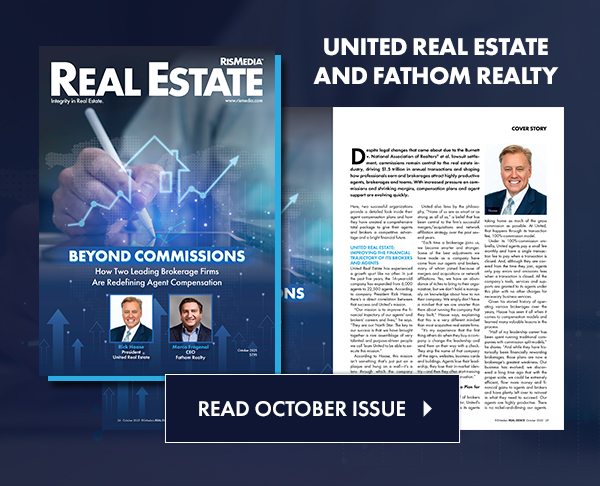It isn’t a secret that real estate agents are, perhaps, just a tad on the older side.
The median age of a Realtor® is 55. Only 11% of active TikTok users in the U.S. are over 50.
But what happens when the younger generations start roasting the types of living situations agents view as highly desirable? Enter Diana Regan, the millennial, Oakland, California-based content creator whose urban planning critiques are going viral—turning the very suburban, car-centric cities that dominate real estate listings into satirical content.
The brains behind @CitiesbyDiana
With around 500,000 followers across Instagram, YouTube and TikTok, she’s turned urban planning commentary into a lucrative career that rivals her previous sales job. Her weapon of choice? Brainrot humor—the kind of absurdist Gen Z slang that includes terms like “sigma,” “skibidi” and “rizz.”
Some of her recurring jokes include:
- “One more lane will fix traffic forever”
- “Most beautiful interstate interchange”
- “True freedom = bumper to bumper traffic”
Her fictional “Lane Man” character, who believes adding more lanes will solve all traffic, has become increasingly popular, even gaining recognition from politicians.
Regan’s content combines AI-generated voiceovers, Google Earth footage and video game content from city-builder and driving games. But what started as casual gaming videos evolved into pointed social commentary.
“I started making little videos that I posted to YouTube, and I started getting lots of comments from people, especially Europeans, saying, ‘Oh, this is such terrible planning. This is so awful. It’s so car-centric.’ And I didn’t know—I was just building what I saw,” she said.
“I can talk about a place and satirize the people and things in this place, using cars as a stand-in for the people…because we all…drive. People are going to see that, and be like, ‘Oh my God; I saw my city in a video game.’ And they think it’s so cool.”
Plenty of people don’t understand the commentary she’s making with her videos—which mock people, philosophies and policies on both sides of the political spectrum, with a smattering of more left-leaning commentary thrown in on occasion.
“I get a lot of people who don’t realize it’s satire and then they might agree with some of the points that are presented as a joke,” she said. “They think I actually feel this way, and it’s funny because I never got into this to make any political statement. It just kind of came. I never got into this to make a point…It’s humor. I just thought it was absurd and funny. That’s it.”
Why it matters: The changing landscape of car culture
Regan’s satire taps into a significant generational shift. Most areas in the U.S. are designed around cars, and urban planning reflects that. There are about 2 billion parking spots in the country, nearly seven per car.
Younger generations are increasingly questioning this status quo:
- From 1983 to 2018, the percentage of 18-year-olds with driver’s licenses has dropped by 24.3%, from 80.4% to 60.9%
- For 20- to 24-year-olds, it dropped 12.7%, from 91.8% to 80.1%
- There is a growing community of anti-car rhetoric—a popular (and vulgar) community on Reddit has 474k members and counting
“I think people are starting to connect the dots. They’re starting to realize, ‘Oh, there’s a lot of decisions that were made by politicians’—and to be fair, it does come from both sides of the aisle—that make it hard to design cities in a way that’s better for everyone.”
When it comes to suburban areas, which are mostly car-dependent, Regan said these areas tend to isolate people.
“The way that we’ve created suburbs—it kind of isolates people, and it’s hard to get around without a car. And of course, a lot of younger people don’t drive, or they drive less,” she said. “The way the suburbs are designed, as-is, just makes it hard to live a life that’s not centered around driving and consumption.”
Drawing from personal experience
Regan’s awareness of urban design challenges started early on. Growing up in rural, car-dependent areas, she couldn’t go anywhere without her parents driving her.
“I remember living out in like the middle of nowhere and the nearest place to buy a soda was two miles away on a country road,” she explained.
As a teenager, Regan lived in more of a suburban area, where there was a bit more going on within walking distance.
“I had that freedom where I was like, ‘Oh I could walk to the liquor store or the pizza place down the street by myself, at 15 years old. I could go get a burrito or whatever. This is so cool,’” Regan said. “Even though it was the suburbs, it was like a step up.”
Despite owning a car now, Regan was car-free for five years and says she would probably do it again, since she lives in a walkable neighborhood and has access to public transportation.
“Especially if I’m going to the city…I’ll take transit. I don’t want to drive,” Regan said. “That should be an option…you shouldn’t have to buy a $10,000 to $20,000 hunk of metal just to participate in society.”
Even though some of her content pokes fun at people obsessed with their cars, Regan said she doesn’t hate them.
“I don’t think cars are bad. I think that planning cities with better walkability and transit in mind actually makes things better for people who do need to drive and who do like to drive, because there’s less traffic,” she said. “Better planning of cities benefits everyone. It benefits drivers, too.”
How does this tie into real estate?
Though Regan hasn’t made “Brainrot-meme-style-content” about the real estate industry, at least not yet, her critiques on suburban sprawl and car dependency is commenting on the very inventory that dominates the real estate market.
A lot of people view buying a house as unattainable, Regan said.
On top of obvious factors like high interest rates, buyers also have to have a high credit score, and that doesn’t come easily for everyone. When Regan paid off her car, her score went up by five points but then down another eight after her card balance went up by $50.
“At some point, people are like, ‘Well, I’m paying the same amount renting, and I don’t want to save up…for a down payment on a house,’” she said.
Cutting out a $5 coffee a couple of times a week isn’t going to be enough when it comes to saving for that down payment either, she added. The cost of these “small luxuries” is “negligible compared to how much the price of real estate has gone up over the past 20 years.”
“A lot of younger people, both Gen Z and millennials, don’t have a lot of savings. It’s hard to save money.
Regan would consider owning if it were a good investment and affordable, but she’s also okay with renting.
“I’m pretty happy where I live. I have a good apartment. And it’s all about perspective and what works for you,” she said. “A lot of people like to rent, too, because they like to move to different places and have that mobility, and it’s harder to do that when you (own) the home.”
Silly things agents do, per @CitiesbyDiana
When thinking of real estate agents, there’s a lot of material she can poke fun at for content. The way they hype up a “not so great” place by calling a small place cozy or calling a fixer-upper charming, Regan said.
She’s seen a lot of agents on social media hyping up places when at the end of the day, “This is just a house in the suburbs,” said Regan.
“But they’ve got to say, ‘It’s in a great neighborhood, great schools, super quiet,’ and it’s like, well, that just means that it’s far away from everywhere,” she said. “Or they’ll say, it’s minutes to downtown, and that ‘minutes to downtown’ is 45 minutes.”
The ghost of Robert Moses
A recurring figure in @CitiesbyDiana is Robert Moses, a former city planner in New York City in the mid-20th century. For many, Moses represents segregationist, exclusionary city design philosophy that guided suburban expansion for decades.
“Basically, he was a guy in New York who manipulated the political machine to the point where he was able to get control of a lot of funding and power and kind of design the city however he wanted,” she explained. “And he basically just thought about it like, ‘Let’s make it as good as possible for cars.’”
Particularly in the outer boroughs of the city, like Brooklyn, Queens and the Bronx, Moses carved up freeways to make sure that people could get from point A to point B in their cars, explained Regan.
“A lot of it was hostile to where he was deliberately targeting lower-income neighborhoods, immigrant neighborhoods, so there was a lot of hostility and racism behind it as well,” she said. “And the thing was, with Robert Moses and his ideas, it inspired a whole generation of planners in the 50s and 60s, that it kind of happened in a lot of cities.”
Some people watch Regan’s content and accuse her of hating cars. They say things like, “Oh, you just want nobody to drive. Oh, you hate freedom,” she says.
Urban planning shouldn’t be a political issue, Regan told RISMedia—it simply gives people more choices.











